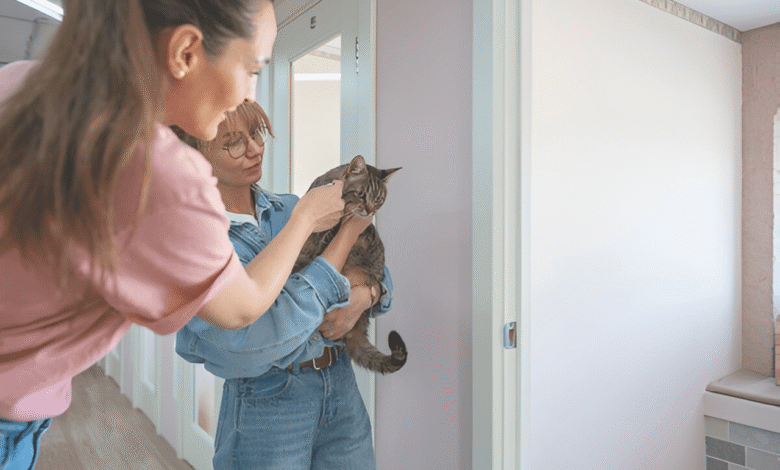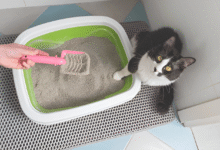
How to Transition Your Cat to a New Home Without Stress
Transition your cat to a new home stress-free with expert tips on safe spaces, routines & calming techniques for a smooth adjustment.
Transition Your Cat to a new home can be a challenging experience for both you and your feline friend. Cats are creatures of habit, and sudden changes in their environment can trigger stress, anxiety, and even behavioral issues. Whether you’re moving across town or to a completely new city, careful planning and patience are key to ensuring a smooth adjustment. By understanding your cat’s needs and following proven strategies, you can minimize disruption and help them feel safe and secure in their new space.
The process of Transition Your Cat to a new home begins long before moving day. Cats rely heavily on familiar scents, routines, and territory to feel comfortable, so a gradual approach works best. From preparing a dedicated safe room to using calming pheromones, small steps can make a big difference in reducing stress. This guide will walk you through practical, vet-approved methods to Transition Your Cat adjust with confidence, ensuring a happy and healthy transition for your beloved pet.
How to Transition Your Cat to a New Home Without Stress
Preparing Your Cat Before the Move
Before the actual move, it’s crucial to Transition Your Cat to the idea of change. Start by keeping their routine as consistent as possible feeding, playtime, and sleep schedules should remain unchanged. Introduce a carrier well in advance if your cat isn’t used to traveling. Leave it open in a familiar space with a soft blanket inside, allowing your cat to explore it voluntarily. Another helpful step is to use pheromone sprays or diffusers, such as Feliway, which mimic natural calming scents. These can reduce anxiety before, during, and after the move. If your cat is particularly nervous, consult your vet about anti-anxiety medications or natural supplements like CBD oil for pets.
Setting Up a Safe Space in the New Home
Upon arrival at the new home, designate a quiet room where Transition Your Cat can adjust without overwhelming stimuli. This space should include familiar items like their bed, litter box, food bowls, and toys. Keeping these items in the same setup as before helps maintain a sense of security. Limit your cat’s access to the entire house initially. Allow them to explore their safe room first before gradually introducing them to other areas. This prevents stress from too much newness at once. Spend time sitting with your cat in this room, offering treats and gentle reassurance to build positive associations with the new environment.
Maintaining a Consistent Routine
Cats thrive on routine, and keeping their schedule consistent is key to reducing stress. Feed them at the same times as before, engage in regular play sessions, and maintain their usual litter box cleaning routine. If your cat had specific habits in the old home (like sleeping in a certain spot), try to replicate those in the new space. Avoid introducing too many changes at once, such as new food or unfamiliar people. Let your cat settle in before making any additional adjustments. Consistency helps reinforce a sense of normalcy, making the transition smoother.
Using Scent Exchange Techniques
Since Transition Your Cat rely heavily on scent, introducing familiar smells can ease their adjustment. Before the move, rub a soft cloth on your cat’s face (where Scent glands are located) and then wipe it on furniture in the new home. This transfers their natural pheromones, making the space feel more familiar. You can also bring unwashed bedding or blankets from the old home to the new one. Placing these items in their safe room helps create a comforting environment. Avoid deep-cleaning their belongings immediately after the move, as the lingering scents provide reassurance.
Gradual Introduction to the New Environment
Once your Transition Your Cat seems comfortable in their safe room, slowly allow them to explore other areas. Start by opening the door and letting them venture out at their own pace. Supervise their exploration to ensure they don’t get overwhelmed or hide in hard-to-reach places. Use treats and positive reinforcement to encourage exploration. If your cat shows signs of stress (hiding, excessive meowing, or refusing to eat), return them to their safe room and try again later. Patience is key some cats adjust in days, while others may take weeks.
Monitoring for Stress and Behavioral Changes
Even with careful planning, some Transition Your Cat may exhibit stress-related behaviors like hiding, excessive grooming, or litter box avoidance. Watch for these signs and respond with extra patience. Provide hiding spots, such as cardboard boxes or covered beds, where your cat can retreat if feeling anxious. If behavioral issues persist, consult a veterinarian or a feline behaviorist. They can recommend additional strategies, such as environmental enrichment (interactive toys, climbing trees) or behavioral therapy. Never punish your cat for stress-related behaviors instead, offer reassurance and support.
Re-establishing Territory and Confidence
Scent Marking for Familiarity
Transition Your Cat to rub their cheeks on furniture this deposits pheromones that signal safety. Place their used bedding around new spaces to transfer comforting scents.
Strategic Scratching Post Placement
Install scratching posts near entryways and sleeping areas. Scratching is a natural territorial behavior that builds confidence through visual and scent marking.
Gradual Room Access Expansion
After initial confinement, open one new room at a time. Supervise exploration and reward with treats to create positive associations with each area.
Interactive Play Sessions
Use wand toys to simulate hunting successful “kills” (catching the toy) release dopamine, reducing stress and reinforcing territory ownership.
Vertical Space Utilization
Add Transition Your Cat trees or wall shelves. Elevated spaces let cats observe their domain safely, mimicking their natural preference for high vantage points.
Read More: How Often Should You Bathe Your Dog? Vet-Backed Advice
Conclusion
Successfully Transition Your Cat to a new home requires patience, understanding, and a thoughtful approach. By creating a safe space, maintaining familiar routines, and Transition Your Cat to adjust at their own pace, you can significantly reduce their stress and help them feel secure in their new environment. Remember that every cat is different some may adapt quickly, while others need more time and reassurance. Your calm presence and consistent care will go a long way in helping them settle in comfortably.
Ultimately, Transition Your Cat to a new home is about providing love, stability, and a sense of familiarity during a period of change. With the right preparation and plenty of positive reinforcement, your feline companion will soon begin exploring, playing, and claiming their new territory. Before you know it, your once-anxious cat will be curled up in their favorite spot, fully at ease in their new forever home. The effort you put in now will strengthen your bond and ensure a happy, stress-free transition for both of you.
How long does it take for a cat to adjust to a new home?
Most cats take 1-2 weeks to adjust, but some may need a month or more, depending on their temperament.
Should I let my cat explore the new home immediately?
No, start with a small, safe room and gradually introduce them to other areas to prevent overwhelm.
What are signs of stress in cats after moving?
Common signs include hiding, excessive meowing, loss of appetite, or litter box avoidance.
Can pheromone diffusers help with the transition?
Yes, products like Feliway mimic calming scents and can reduce anxiety during the move.
Should I change my cat’s routine after moving?
No, keep their feeding, play, and sleep schedule as consistent as possible to provide stability.







